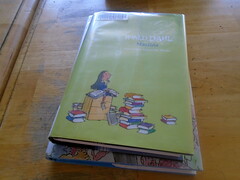Matilda, a novel for children by Roald Dahl first published in 1988, focuses on a precocious young girl whose parents mostly ignore her. Matilda attends an elementary school run by the abusive Headmistress Trunchbull, who hates children. Writing with a lot of figurative language and repeated sounds, Dahl shows readers how Matilda changes her life and the lives of those around her by using her intellect and imagination.
Mr. and Mrs. Wormwood “show no interest” in their daughter Matilda, despite her being both “sensitive and brilliant” (“The Reader of Books,” p. 10). While Mr. Wormwood works selling cars that are wrecks and Mrs. Wormwood plays Bingo, they leave their daughter home alone every afternoon. By the age of three, the girl has taught herself to read, and at age four, she asks her father to buy her a book (pp. 12, 23-24). He refuses, suggesting that Matilda watch television instead. But the child discovers the local public library and reads all of the children’s books there (p. 13). Then the librarian, Mrs. Phelps, recommends good adult books for the young girl such as Charles Dickens’ Great Expectations, Charlotte Bronte’s Jane Eyre, and Ernest Hemingway’s The Old Man and the Sea (pp. 15-18).
Despite her intelligence, Matilda suffers because her clueless parents constantly insult her, calling their daughter “ignorant and stupid” (“Mr. Wormwood, the Great Car Dealer,” p. 29).
At the age of five, Matilda decides to get revenge on her parents when they abuse her (p. 29). For example, she puts Superglue inside her father’s favorite hat, which makes it impossible for him to remove the hat. Finally, Mrs. Wormwood cuts the hat off his head, but some hair gets removed, too (“The Hat and the Superglue,” pp. 30-36).
Dahl emphasizes his main points by using similes, metaphors, and repetition of sounds. For example, after Matilda’s Superglue trick, Mr. Wormwood behaves himself for a week, “and he seemed temporarily to have lost his taste for boasting and bullying” (“The Ghost,” p. 38). This clause repeats a lot of t, st, b, m, and l sounds. However, Mr. Wormwood soon reverts to his abuse of Matilda. After a bad day, he returns home with his face “as dark as a thunder-cloud” (p. 38). This simile highlights the man’s angry mood. He takes out his frustration on his daughter, seizing Matilda’s novel from the library and ripping its pages out (pp. 39-41). Instead of crying or pouting, Matilda plans “another suitable punishment for the poisonous parent” (p. 41). The consonance and alliteration draw readers’ attention to Dahl’s key words.
Because Matilda’s spacey parents did not bother to register her for school, she does not start Crunchem Hall Primary School until age five and a half (“Miss Honey,” 66). The school’s name implies that this institution aims to “crunch” the children instead of treating them with respect. In fact, the huge middle-aged headmistress, Miss Trunchbull, hates youngsters and frequently torments the students. Dahl describes her with similes, assonance, and consonance that emphasize her sadism. “She was a gigantic holy terror, a fierce tyrannical monster who frightened the life out of the pupils and teachers alike. There was an aura of menace about her even at a distance, and when she came up close you could almost feel the dangerous heat radiating from her as from a red-hot rod of metal. . . . [S]he always marched like a stormtrooper” (p. 67). On the first day of class, Miss Honey warns her students to obey Miss Trunchbull: “If you get on the wrong side of Miss Trunchbull, she can liquidize you like a carrot in a kitchen blender” (p. 69).
In contrast to Miss Trunchbull, Matilda’s teacher, Miss Honey, is “a mild and quiet person who never raised her voice” (“Miss Honey, p. 66). Students love Miss Honey because of her kindness and empathy for them (p. 67). Miss Honey recognizes Matilda’s genius on the first day of class (pp. 73-81; “The Trunchbull,” p. 87) and asks Headmistress Trunchbull to let Matilda skip from the youngest class to the oldest class in the school (eleven-year-old students). However, Miss Trunchbull refuses to allow this transfer (pp. 88-89).
So Miss Honey goes to Mr. and Mrs. Wormwood to convince them to allow brilliant Matilda to get private tutoring from her teacher (“The Parents,” p. 92). But they refuse.
There are three small flaws in Matilda. Dahl does not give clues about the teacher Miss Honey’s poverty until late in the novel (Miss Honey’s Story,” pp. 193, 200-205). Also, Dahl shifts the center of consciousness away from Matilda for one chapter entitled “Lavender” to focus on the student Lavender’s preparation for scaring Miss Trunchbull by putting a newt in her drinking water pitcher. Matilda is a much more interesting center of consciousness. Thirdly, we do not find out that Miss Honey is Trunchbull’s niece until very late in the novel (“Miss Honey’s Story,” p. 205).
Dahl arranges a happy ending for this story. In the real world, schools often neglect gifted children like Matilda to focus on more average students. And parents often have friction with their brilliant offspring because smart children may rebel more often. I wish that all precocious children got the attention and nurturing that they need.

Cover of Matilda by Roald Dahl